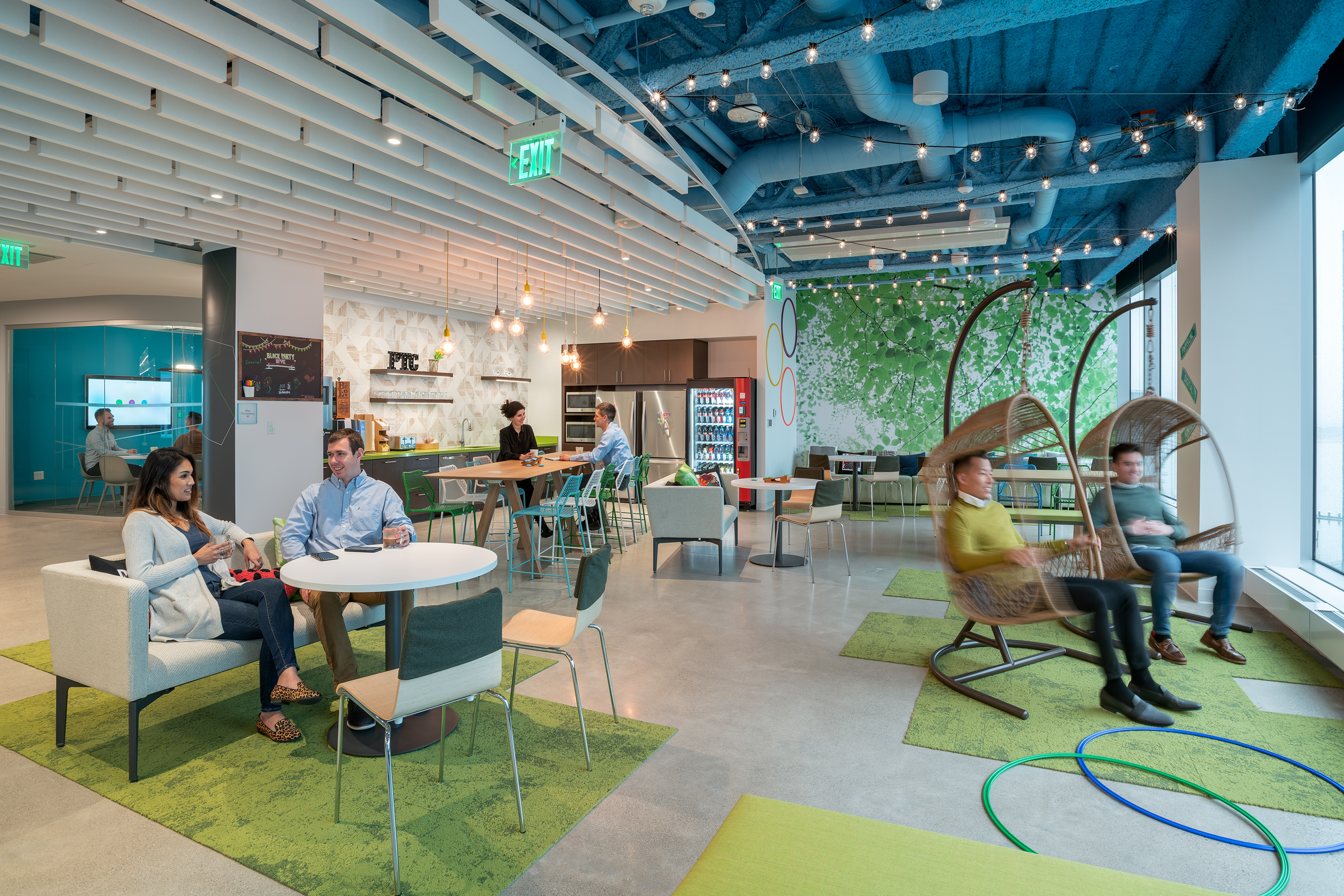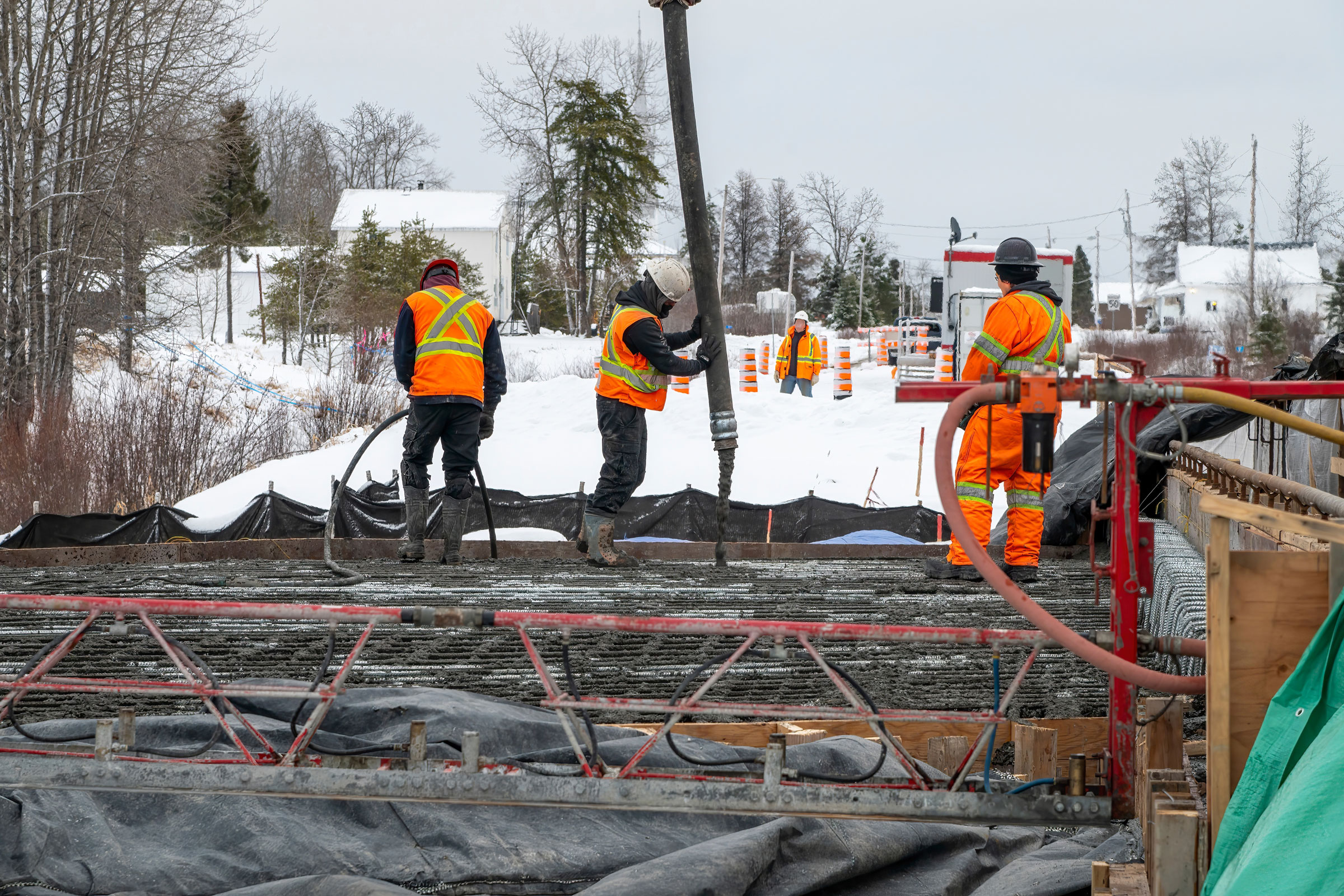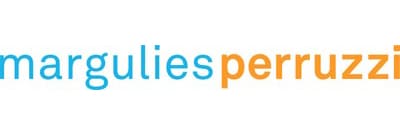Launched in July 2020 by the International WELL Building Institute (IWBI), the WELL Health-Safety Rating is a concept whose time has come, especially as businesses, institutions, and organizations strive to return to an updated version of pre-pandemic normalcy.
IWBI defines the WELL Health-Safety Rating as “an evidence-based, third-party verified rating focused on operational policies, maintenance protocols and emergency plans to address a post-COVID-19 environment now and broader health and safety-related issues into the future.”
The idea was forged during the pandemic’s first wave, one of the earliest results of IWBI’s task force on Covid-19. According to IWBI, “nearly 600 public health experts, virologists, government officials, academics, business leaders, architects, designers, building scientists and real estate professionals” participated.
The WELL Health-Safety Rating contains a subset of relevant features from the WELL Building Standard that were adapted for a facilities and operations focus. It promotes indoor safety by providing a means to guide, validate, recognize, and scale management of health and safety issues in shared spaces. IWBI states that “third-party review ensures integrity and consistency, and results in a WELL Health-Safety seal for buildings and spaces that meet the rating’s requirements, communicating leadership and a commitment to the health and well-being of the people who frequent the space.”
At Margulies Peruzzi, we believe that this rating system is to health and safety what LEED is to sustainable design, and that it will gain the same traction among design professionals and owners. Directed towards facility operations and management, the rating is applicable to all new and existing building and facility types across an array of markets and organizations. IWBI cites some recognizable names among those that have achieved the rating: Prudential Center, Fairfax County Public Schools, Yankee Stadium, Empire State Realty Trust, JPMorgan Chase, T-Mobile, Four Seasons, Citi, and Brookfield Properties.
The advantages of the WELL Health-Safety Rating are numerous: attracting and retaining employees, clients, and investors; building brand equity through leadership and innovation; and promoting employee health and well-being and in doing so, maximizing productivity.
Program Features
The rating system examines more than 20 features across six main themes—Cleaning and Sanitization Procedures, Emergency Preparedness Programs, Health Service Resources, Air and Water Quality Management, Stakeholder Engagement and Communication, and Innovation. For a facility to earn a WELL Health-Safety seal, a minimum of 15 criteria must be met, including as many as three submissions under Innovation. IWBI provides collateral material, a detailed online guide, and an extensive checklist to help participants through the process. Like the US Green Building Council’s LEED project certification, there is a cost attached to earning this rating. It ranges from a low of $2,730 for a small business at a single location to a capped high of $166,000 for a company with up to to 10,000 locations.
In another similarity to LEED, Green Building Certification Inc. (GBCI) in collaboration with IWBI developed a rigorous process for individual accreditation. Becoming a WELL accredited professional (AP) signifies advanced knowledge in human health and wellness in the built environment and specialization in the WELL Building Standard.
Workplace Research in the Time of Covid

Photo courtesy of Warren Patterson Photography
The workspace is an important physical asset within which a high degree of ingenuity and productivity is enabled. Thus inspired, we launched our first workplace strategy research in 2016, drawing on more than two decades of working with countless companies to help them create optimal work environments. Research continued, and in early 2020 when the world as we knew it changed, we shifted our focus—much like IWBI’s task force—to examining the ramifications of Covid-19 on physical work environments and their occupants.
Kicking off a series of five reports that share current thought leadership on the nature of work and how it and office environments are evolving during this health crisis was Volume 1: Covid-19 and the Future of the Workplace, published in May 2020. It presents the results of a survey we conducted of thousands of industry professionals to gain an understanding of the virus’s impact on the physical office environment. We received more than 500 responses to several fundamental questions:
- When asked what most excited them about the prospect of returning to their workplace, 90% of respondents cited collaborating in person again and reuniting with colleagues. Coming in second was accessing office resources and equipment (64%), followed by returning to a well-designed, ergonomic workspace (58%) and working in environment that allows them to focus (47%).
- Regarding their concerns, 80% cited safety in common spaces, followed by social distancing in meeting and collaboration space (70%); work environment cleanliness (68%); interaction with the public, visitors, and vendors (66%); workspace density (60%); and air quality (38%).
- Working from home provided valuable lessons learned. “Space to concentrate is important” garnered 87% agreement. Other feedback acknowledged the desirability of face-to-face interaction (83%); value of engagement with company culture and mission (82%); ability to be productive remotely (82%); importance of ergonomics (75%); and ability to manage teams remotely (73%).
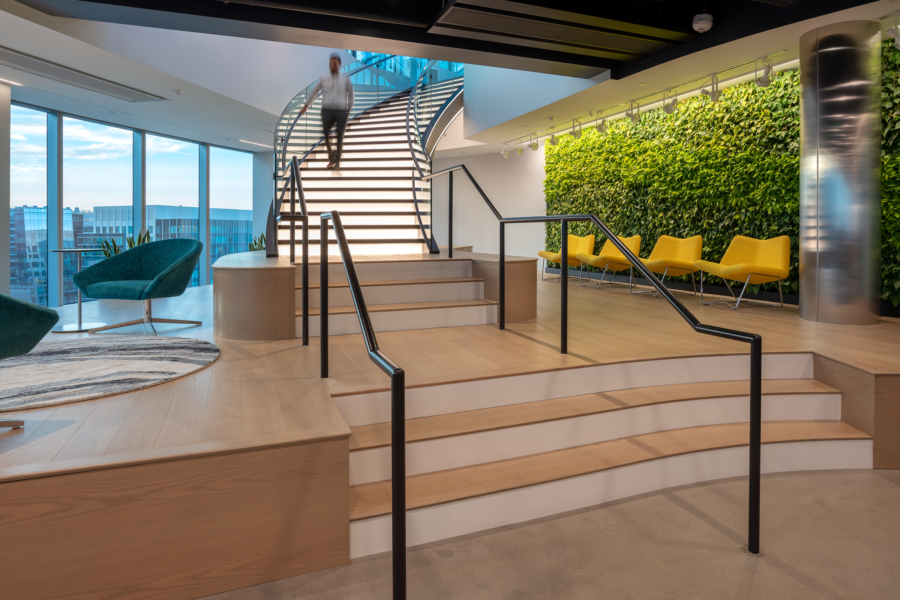
Photo courtesy of Warren Patterson Photography
The report features a 10-page section, “Re-Thinking Office Building & Workplace Design,” that contains product reviews and explores various options that align with WELL Health-Safety Rating features under Air and Water Quality Management, Stakeholder Engagement & Communication, and Innovation. These include MEP improvements; UV lighting for treatment of air and surfaces; screening devices and sensors; information technology; wellness standards that go beyond FitWel, LEED, and WELL Building; social changes; furniture solutions; antimicrobial surfaces; infection control risk assessment; and HR strategies for remote and hybrid work.
Volume 2: Reshaping the Workplace was published in August 2020. It asks the key question, “What does the future of office design look like?” in a post-Covid future and explores impacts on real estate, space metrics and ratios, new concepts in space design, and technologies for space management. Among the challenges that owners and facility managers can look forward to are increases in workplace utilization rates, safety protocols, and need of technology for collaboration; management of a reduced in-person population due to continued remote work; and restoration of employee engagement and culture. It was around this time that the concept of a hybrid work model began to emerge, which intersects with features under four of the six WELL Health-Safety Rating themes.
Rethinking the Corporate Office Building
With a total inventory of over 5.5 billion square feet of office space leased or available for lease in the United States at the end of June 2021, landlords are in the vanguard of building owners who must adapt their assets to support the health and safety of current and prospective tenants. Margulies Peruzzi’s Volume 3: Building Design Reimagined/How Will Covid-19 Affect Building Design? research, published in September 2020, provides practical guidance to landlords specific to market challenges, tenant needs, building improvements, and space management.
The primary logistical and financial challenges we foresaw as tenants returned were the ability to comply with social distancing in common areas, the need to increase security and safety protocols, improving HVAC performance and outside air intake, providing hands-free options, and reductions in public transportation and on-site employees.
Predicting that tenants would have many questions of landlords, the report provided a substantial list that included “What WELL/LEED standards do you have in place?” We forecast that traditional building amenities such as serveries and fitness centers would take on new forms and procedures and that other innovations, such as refrigerated marketplaces and moving conference areas close to lobbies to reduce foot traffic through office spaces, would become more common. Presented in two categories (existing and new buildings), the report contains recommendations for potential improvements to parking and building entrances; building lobbies and security desks; elevator lobbies; elevator technology; restroom layout and design; grab-n-go, cafes, and food pickup; markets; fitness centers; HVAC systems and the energy code; and building control systems.
The Path Forward
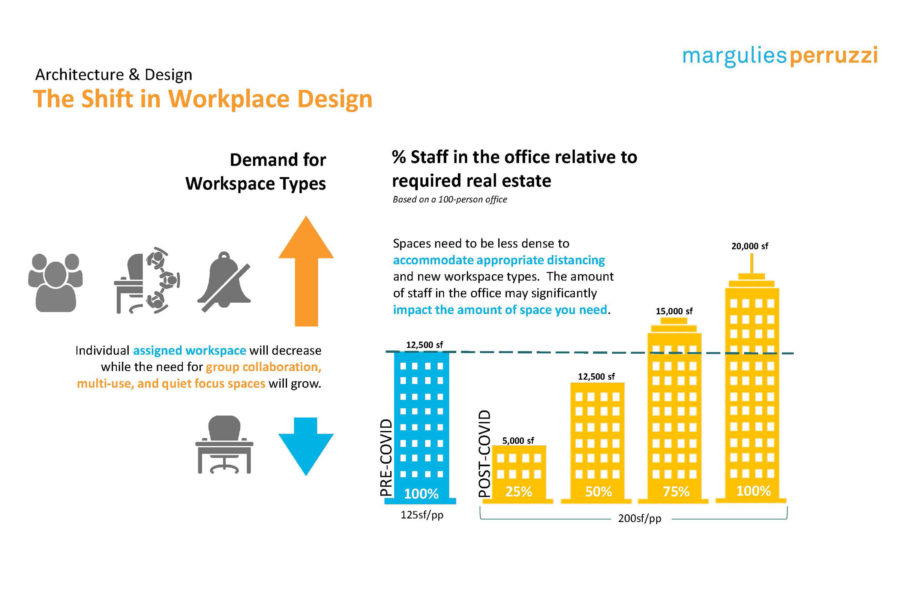
Courtesy of Margulies Perruzzi
The shape of future office environments will be largely determined by three factors: the ability of company leaders to direct and manage change; the subsequent development of organization-wide policies concerning remote work, safety, and occupancy; and the financial implications of those policies on facility decisions. A successful transition from the peak pandemic work-from-home scenario to a return-to-office scenario will require a spectrum of expertise and depend heavily on corporate agility and flexibility. Features of the WELL Health-Safety Rating’s Emergency Preparedness Programs theme, in particular the development of emergency, business continuity, and healthy re-entry plans, have a direct bearing on future space planning and allocation.
Margulies Perruzzi’s January 2021 report, Volume 4: Post-COVID Workplace (link) presents four workplace models that corporate leaders can adapt to their own company’s unique blueprint. They are traditional, flexible, balanced, and lean, and range in 25% increments from 100% of the workforce returning to the office in the traditional model, to 25% in the lean model. Each model comes with its own financial and logistical considerations, especially if more space is needed to accommodate social distancing. The graphic below demonstrates how the models compare in terms of cost and space.
The New Hybrid Environment
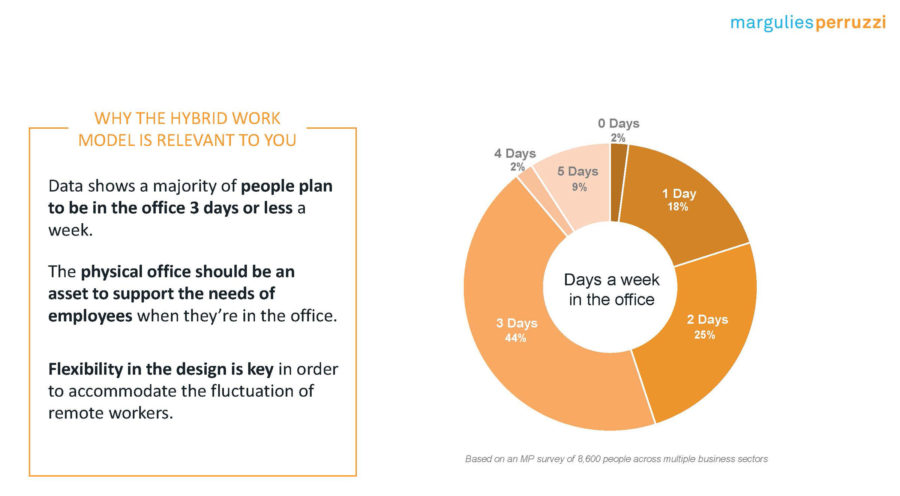
Courtesy of Margulies Perruzzi
Long a staple in certain high-tech industries and made possible through advancements in digital technology, the hybrid work environment model is now mainstream thanks to the Covid-19 pandemic. As the world grapples with the delta variant and new facts about its transmissibility to and by the vaccinated, Margulies Perruzzi’s just-released Volume 5 Workplace Strategy Report: Embracing the Hybrid Workspace affirms the logic of transitioning from a traditional to hybrid model. A survey of 8,600 people across multiple business sectors revealed that 44% of workers plan on being in the office three days a week, and 25% plan on two days. Only 9% responded that they would return to a pre-pandemic office presence.
Corporate leaders are becoming more receptive to the idea that work environments must embrace change as a constant and evolve in response. Catalysts include an increase in workplace utilization rates and safety protocols; restoration of employee engagement and culture; continuation of remote work and subsequent management of a reduced in-person population; and an increased need for collaboration technology and training.
Planning a return to the physical office under ever-changing conditions and advisories from the CDC is yet one more challenge for C-suite executives, facility managers, and employees. The numbers are significant. According to the US Bureau of Labor Statistics, as of July 2021, there were 153.6 million people aged 16 and over in America’s workforce, of which 82.2 million are office-based. Of those, 13.2% of full-time workers in all industries engaged in remote work. Although this is down from a high of 35.4% in May 2020, it nevertheless represents more than 10 million workers. That’s a lot of people, square footage, furniture, equipment, and associated costs to consider while simultaneously prioritizing health and safety.
Managing Change
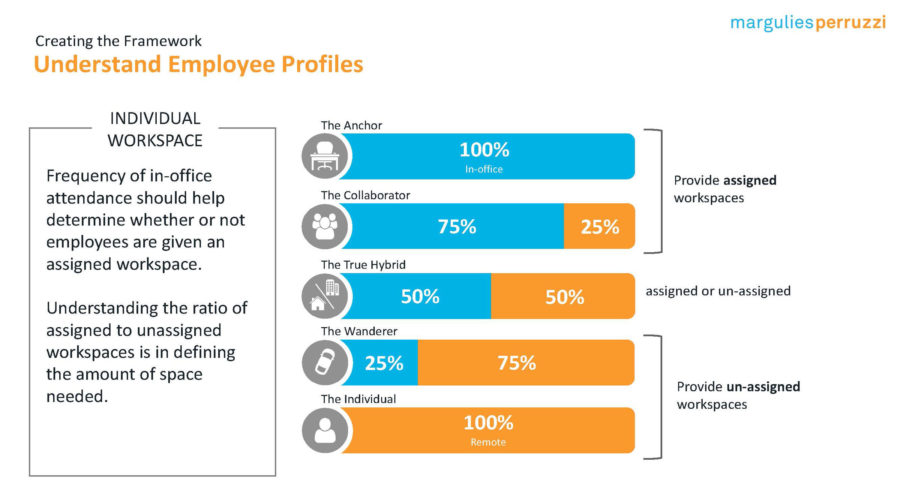
Courtesy of Margulies Perruzzi
Change is difficult, but meaningful change cannot happen in a vacuum or without confident leadership. Approaching it in an analytical and positive manner can diminish fear of the unknown and promote inclusivity. Informed corporate leaders are adopting sequential steps for creating a practical, sustainable strategy for their companies, the first one being the creation of a framework that identifies employee type profiles and their correlative space needs.
Once the framework has been established, the next steps are to:
- Determine corporate willingness to change and how to build consensus around change.
- Set guidelines for remote work and HR policies.
- Confirm the financial implications.
- Introduce property technology to manage space utilization on an ongoing basis.
- Develop architectural, design, and engineering principles.
- Form an implementation plan.
There are many different options available for implementing a safe return to the office, but there is no one-size-fits-all solution. The most successful solution will be that which is uniquely tailored to a company’s business model, strategic plan, and corporate culture. Flexibility of both thought and design are the keys to cultivating a successful hybrid work environment.
Drawing a final correlation to LEED, many companies opt to have their facilities designed to various LEED certification levels without pursuing registration. The same approach can be taken with the WELL Health-Safety Rating. Although we advocate participation in both programs, only an owner can weigh the value of either investment against their project goals and budget.
Health and Safety Efforts Backed by Science
Program participants are in excellent company. According to IWBI, globally there are 20,950-plus assets enrolled totaling 1.8 billion square feet, with 13,340-plus and 1.3 billion square feet rated. At the end of the process, the WELL Health-Safety seal is a tangible and visible reminder that your building’s health and safety efforts are backed by science and validated by a third party. Seeing the seal outside tells employees, visitors, clients, and customers that they will be safe inside.

